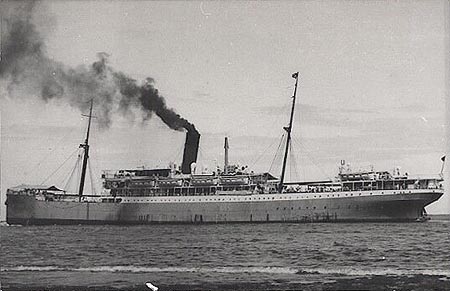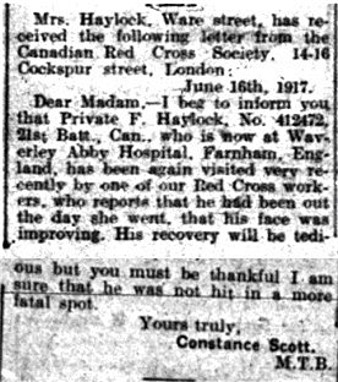|
Jan 8, 1887
|
Born in Cambridge, England to Charles and
Elizabeth Jane (nee Skinner) Haylock
|
|
Aug 9, 1911
|
Married to Harriet Sarah Fisher in Peterborough,
Ontario
|
|
Feb 18, 1915
|
Attested into the 39th Battalion in
Peterborough, Ontario
Ø Number 412478
Ø Next of kin given as Harriet Haylock, wife, 52 Ware St., Peterborough,
Ontario
o The address was recorded as Weir St., but the correct spelling is Ware
St.
Ø Previous occupation given as Assembler
Ø No previous military experience given
Ø Religion given as Church of England
Ø Assigned to the Headquarters Staff
The battalion trained in the Belleville, Ontario
area
|
|
Apr 11, 1915
|
Admitted to the Belleville Hospital with a
diagnosis that reads Influenza
|
|
Apr 15, 1915
|
Discharged to duty from hospital
|
|
May 10, 1915
|
Admitted to the Belleville Hospital with a
diagnosis that reads Grippe
|
|
May 15, 1915
|
Discharged to duty from hospital
|
|
Jun 17, 1915
|
Embarked the SS Missanabie in Montreal, Quebec

|
|
Jul 3, 1915
|
Disembarked in Plymouth, England and proceeded
to Shorncliffe and then on to Lydd to continue training
|
|
Sep 20, 1915
|
To receive 75¢ per day
working pay as a Pioneer
|
|
Sep 24, 1915
|
The 39th Battalion moved to West
Sandling to continue training
|
|
Oct 26, 1915
|
Working pay discontinued
|
|
Jun 6, 1916
|
Transferred to the 21st Battalion
|
|
Jun 7, 1916
|
Arrived at the CBD (Canadian Base Depot) in the
Rouelles Camp, Havre, France as part of a draft of 48 reinforcements from England and TOS
(Taken On Strength) the 21st Battalion
|
|
Jun 15, 1916
|
After leaving the CBD he joined the 21st
Battalion in the front line 33 to 38 trenches near Verbrande Molen, Belgium
|
|
Sep 6, 1916
|
Admitted to the No. 6 CFA (Canadian Field
Ambulance) with a diagnosis that reads PUO (Pyrexia of Unknown Origin). This is a fever without a known cause
|
|
Sep 8, 1916
|
Transferred to the Divisional Rest Station at
the No. 5 CFA for treatment at Val de Maison, north of Amiens
|
|
Sep 13, 1916
|
Transferred to the No. 8 CFA to continue his
recovery
|
|
Sep 15, 1916
|
Discharged to duty from the CFA
|
|
Nov 6, 1916
|
Attached to the Trench Mortar Company of the 1st
Army for duty
|
|
Nov 21, 1916
|
Rejoined the 21st Battalion from the
trench mortar company
|
|
Dec 14, 1916
|
Attached to the 4th
Canadian Trench Mortar Battery for duty
|
|
Apr 9, 1917
|
During the advance on
Vimy Ridge by the Canadian Corps, the 4th Trench Mortar Battery supported the
troops from close range. Private Haylock was
shot in the jaw by a sniper. The bullet entered the lower jaw, fracturing it in
2 places before exiting. He was first treated
at the nearby field ambulance before being transported to the casualty clearing station
for further treatment
|
|
Apr 17, 1917
|
Transferred to the No. 2 Canadian General
Hospital in Havre and placed on the dangerously ill list
|
|
Apr 22, 1917
|
Removed from the dangerously ill list and
invalided to England aboard the Hospital Ship Grantully Castle

On arrival in England he was admitted to the
Cambridge Hospital in Aldershot where several surgeries were performed to remove bone
fragments, install steel plates and to wire the jaw closed in order to aid the healing
process
According to the letter below from the
Peterborough Examiner dated July 4, 1917, he was a patient in the Waverley Abbey Hospital
in Farnham, however there is no mention of this in his service file.

Posted to the EORD (Eastern Ontario Regimental
Depot) for pay purposes while in hospital
|
|
Aug 22, 1917
|
Transferred to the Queen’s Military
Hospital in Frognal, Sidcup
|
|
Oct 27, 1917
|
Transferred to the No. 16 Canadian General
Hospital (Ontario Military Hospital) in Orpington, Kent
|
|
Jan 5, 1918
|
Transferred to the No. 5 Canadian General
Hospital in Kirkdale
|
|
Feb 4, 1918
|
Invalided to Canada and embarked the Hospital Ship
Araguaya in Liverpool

|
|
Feb 16, 1918
|
Disembarked in Halifax, Nova Scotia and
proceeded to Kingston, Ontario
TOS Military District #3 in Kingston
|
|
Feb 21, 1918
|
Admitted to the Queen St. Military Hospital,
Kingston
|
|
Apr 24, 1918
|
Discharged from the CEF into the care of the
DSCR (Department of Soldier’s Civil Re-Establishment) while still in hospital
Ø Rank on discharge Private
Ø War service badge Class “A” issued
Ø Proposed residence on discharge 47 Ware St, Peterborough, Ontario
|
|
Apr 29, 1918
|
Discharged from hospital and proceeded home to
Peterborough
|
|
Aug 17, 1918
|
Admitted to the Nicholls Hospital in
Peterborough with severe abdominal pain where a solid mass could be felt
|
|
Sep 3, 1918
|
Surgery was performed to remove a blockage in
the bowel. This was a result of his
inability to chew solid food from because of his fractured jaw
|
|
Sep 9, 1918
|
Following the surgery complications set in and
he developed Peritonitis, which caused his death at 3.50 am.
He was buried in the Little Lake Cemetery,
Peterborough

Following his death the British War Medal,
Victory Medal, Plaque (Dead Man’s Penny), Scroll and Memorial Cross were sent to his
widow, Mrs. H. Haylock, 611 Chamberlain St., Brownton Post Office, Peterborough,
Ontario
A second Memorial Cross was sent to his mother,
Mrs. Elizabeth Haylock, Bury St. Edmunds, Suffolk, England
|
|